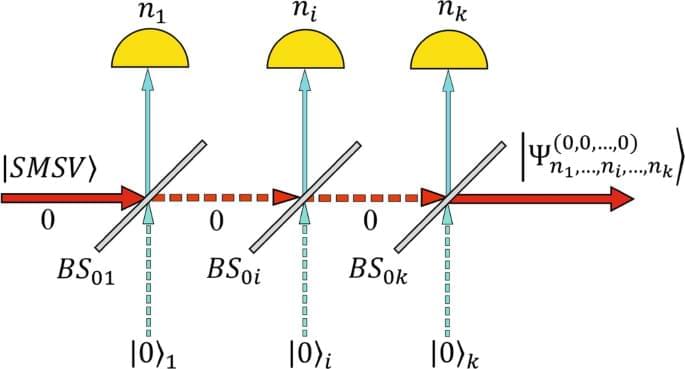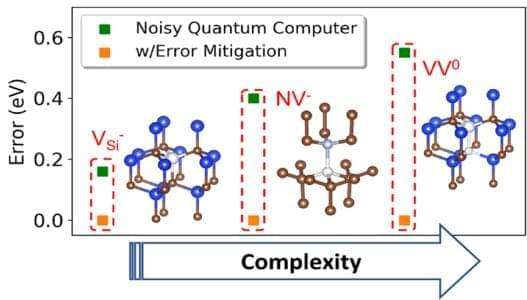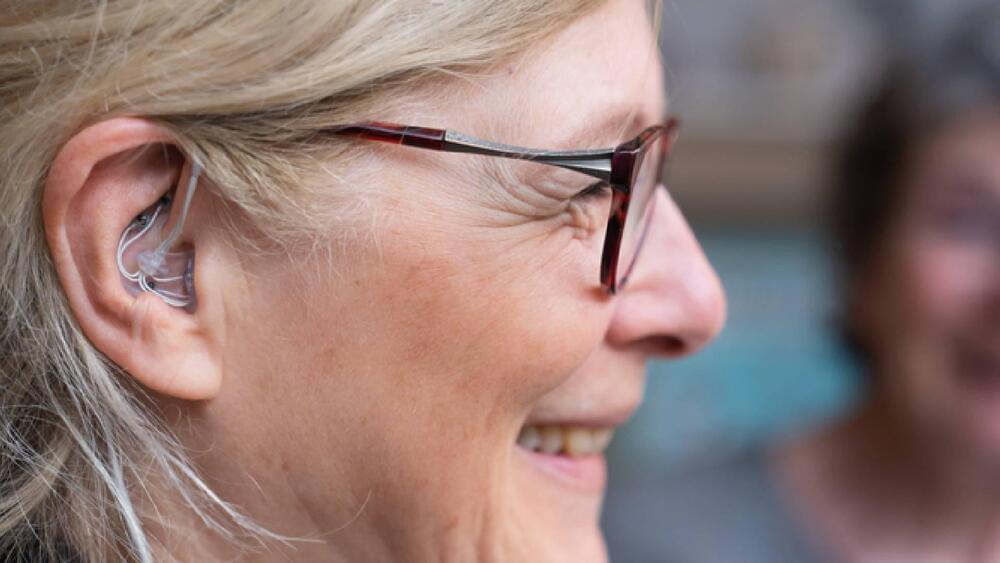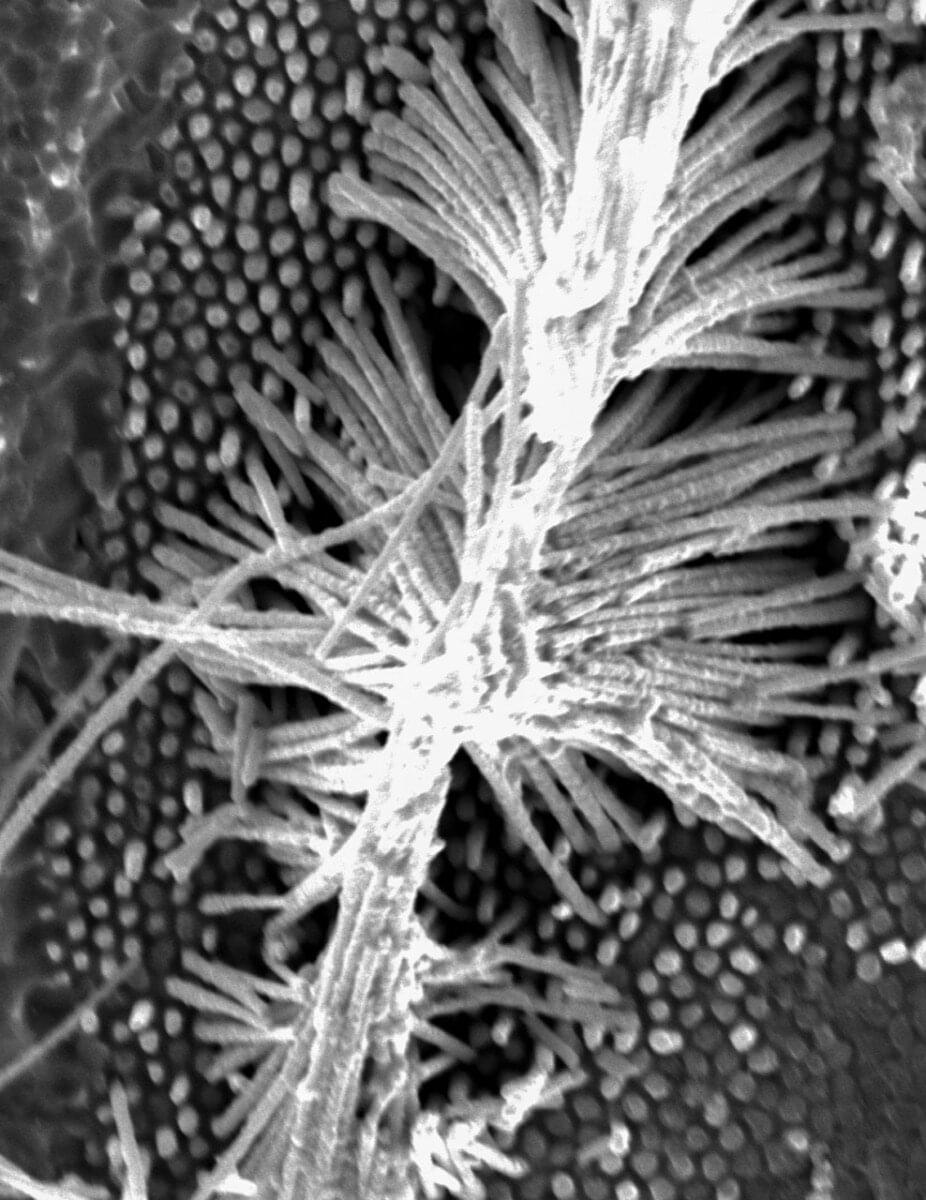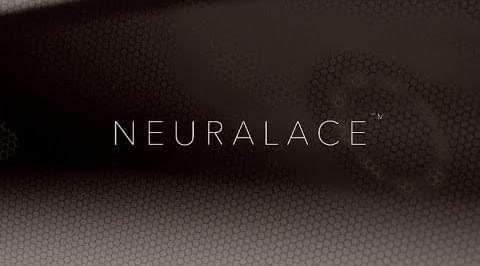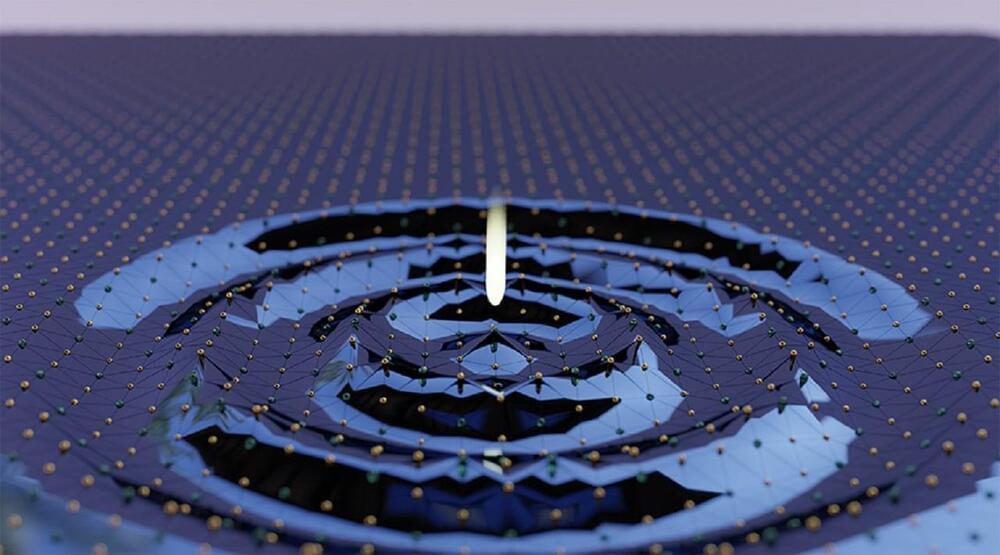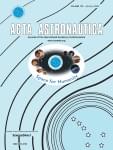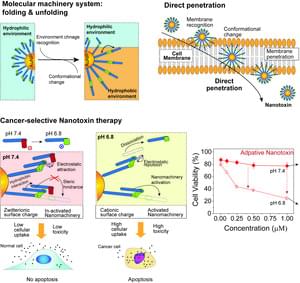We present an algorithm of quantum engineering of large-amplitude $$\ge 5$$ high-fidelity $$\ge 0.99$$ even/odd Schrödinger cat states (SCSs) using a single mode squeezed vacuum (SMSV) state as resource. Set of $$k$$ beam splitters (BSs) with arbitrary transmittance and reflectance coefficients sequentially following each other acts as a hub that redirects a multiphoton state into the measuring modes simultaneously measured by photon number resolving (PNR) detectors. We show that the multiphoton state splitting guarantees significant increase of the success probability of the SCSs generator compared to its implementation in a single PNR detector version and imposes less requirements on ideal PNR detectors.
Category: engineering – Page 65
If you know the atoms that compose a particular molecule or solid material, the interactions between those atoms can be determined computationally, by solving quantum mechanical equations—at least, if the molecule is small and simple. However, solving these equations, critical for fields from materials engineering to drug design, requires a prohibitively long computational time for complex molecules and materials.
Now, researchers at the U.S. Department of Energy’s (DOE) Argonne National Laboratory and the University of Chicago’s Pritzker School of Molecular Engineering (PME) and Department of Chemistry have explored the possibility of solving these electronic structures using a quantum computer.
The research, which uses a combination of new computational approaches, was published online in the Journal of Chemical Theory and Computation. It was supported by Q-NEXT, a DOE National Quantum Information Science Research Center led by Argonne, and by the Midwest Integrated Center for Computational Materials (MICCoM).
A new project called Progression Assessment in Neurodegenerative Disorders of Aging or PANDA aims to detect subtle changes in a person’s sleep patterns that may indicate the onset of Alzheimer’s or Parkinson’s disease. The collaboration of this four-year project involves Rigshospitalet University, Denmark’s Aarhus University, and MedTech company T&W Engineering. The project has received funding of DKK 15 million to develop and test a small earbud-like experimental device that can detect the early signs of these diseases.
The Ear-EEG Technology
Unlike the traditional sleep-monitoring systems that require a person to stay in a clinic with multiple electrodes attached to their body, the ear-EEG allows for comfortable, long-term use at home. The device monitors electrical activity in the brain by measuring tiny voltage changes on the skin surface within the ear canal. It is also equipped with an oximeter for measuring blood oxygen levels, a microphone for monitoring respiration and heart rate, and a thermometer for measuring body temperature.
Sometimes to make big breakthroughs, you have to start very small.
One way that scientists can get the most out of certain quantum materials is by fabricating nanoscale structures that generate new properties at the material’s surfaces and edges. Cornell researchers used the relatively straightforward process of thermomechanical nanomolding to create single-crystalline nanowires that can enable metastable phases that would otherwise be difficult to achieve with conventional methods.
“We’re really interested in this synthesis method of nanomolding because it allows us to make many different kinds of materials into nanoscale quickly and easily, yet with some of the control that other nanomaterial synthesis methods lack, particularly control over the morphology and the size,” said Judy Cha, professor of materials science and engineering in Cornell Engineering, who led the project.
Play ransomware is notable for not only utilizing intermittent encryption to speed up the process, but also for the fact that it’s not operated on a ransomware-as-a-service (RaaS) model. Evidence gathered so far points to Balloonfly carrying out the ransomware attacks as well as developing the malware themselves.
Grixba and VSS Copying Tool are the latest in a long list of proprietary tools such as Exmatter, Exbyte, and PowerShell-based scripts that are used by ransomware actors to establish more control over their operations, while also adding extra layers of complexity to persist in compromised environments and evade detection.
Another technique increasingly adopted by financially-motivated groups is the use of the Go programming language to develop cross-platform malware and resist analysis and reverse engineering efforts.
Neuralace™ is a glimpse of what’s possible in the future of BCI.
This patent pending concept technology is the start of Blackrock’s journey toward whole-brain data capture–with transformative potential for the way neurological disorders are treated. With over 10,000 channels and a flexible lace structure that seamlessly conforms to the brain, Neuralace has potential applications in vision and memory restoration, performance prediction, and the treatment of mental health disorders like depression.
Neuralace is:
Ultra-High Channel Count | Wireless | Customizable | Flexible | Thinner than an eyelash.
The possibilities are endless… Whole-brain data capture | Seamless connectivity | Improved biocompatibility About Blackrock Neurotech Blackrock Neurotech is a team of the world’s leading engineers, neuroscientists, and visionaries. Our mission is simple: We want people with neurological disorders to walk, talk, see, hear, and feel again. We’re engineering the next generation of neural implants, including implantable brain-computer interface technology that restores function and independence to individuals with neurological disorders. Join us in changing lives today. Connect with us: Join Our Team | https://bit.ly/3bCsXRv LinkedIn | https://bit.ly/3PfifOL Twitter | https://bit.ly/3PfifOL Instagram | https://bit.ly/3bMaYrW Facebook | https://bit.ly/3JRc2av Clinical Trials | https://bit.ly/3A8QPWm Our site | https://blackrockneurotech.com.
There are high expectations that quantum computers may deliver revolutionary new possibilities for simulating chemical processes. This could have a major impact on everything from the development of new pharmaceuticals to new materials. Researchers at Chalmers University have now, for the first time in Sweden, used a quantum computer to undertake calculations within a real-life case in chemistry.
“Quantum computers could in theory be used to handle cases where electrons and atomic nuclei move in more complicated ways. If we can learn to utilize their full potential, we should be able to advance the boundaries of what is possible to calculate and understand,” says Martin Rahm, Associate Professor in Theoretical Chemistry at the Department of Chemistry and Chemical Engineering, who has led the study.
Within the field of quantum chemistry, the laws of quantum mechanics are used to understand which chemical reactions are possible, which structures and materials can be developed, and what characteristics they have. Such studies are normally undertaken with the help of super computers, built with conventional logical circuits. There is however a limit for which calculations conventional computers can handle. Because the laws of quantum mechanics describe the behavior of nature on a subatomic level, many researchers believe that a quantum computer should be better equipped to perform molecular calculations than a conventional computer.
Interfacial superconductivity and the quantum anomalous Hall effect have been developed by layer-by-layer material fabrication.
A new method created by Pritzker School of Molecular Engineering (PME) researchers can help determine the origin of electronic states in designed materials.
Assistant Professor Shuolong Yang and his colleagues created a method for better understanding magnetic topological insulators, which have unique surface properties that could make them useful in quantum information science technologies.
Year 2023 face_with_colon_three
If humanity is ever to consider substantial, long-term colonization of Mars, the resources needed are going to be extensive. For a long-term human presence on Mars to be established, serious thought would need to be given to terraforming the planet. One major requirement for such terraforming is having the protection of a planetary magnetic field — which Mars currently does not have. The Earth’s magnetosphere helps protect the planet from the potential sterilizing effects of cosmic rays and also helps retain the atmosphere, which would otherwise by stripped by large solar storms as they pass over the planet. Mars does have small patches of remnant surface magnetic field, but these are localized in the southern hemisphere and are not of sufficient size or magnitude to protect the planet or a colony.
In this article we explore comprehensively for the first time, the practical and engineering challenges that affect the feasibility of creating an artificial magnetic field capable of encompassing Mars. This includes the concerns that define the design, where to locate the magnetic field generator and possible construction strategies. The rationale here is not to justify the need for a planetary magnetosphere but to put figures on the practicalities so as to be able to weigh the pros and cons of the different engineering approaches.
The optimum solution proposed is completely novel, although inspired by natural situations and fusion plasma techniques. The solution with the lowest power, assembly and mass is to create an artificial charged particle ring (similar in form to a ‘radiation belt’), around the planet possibly formed by ejecting matter from one of the moons of Mars (in a fashion similar to that which forms the Jupiter-Io plasma torus), but using electromagnetic and plasma waves to drive a net current in the ring(s) that results in an overall magnetic field.
Proteins are involved in every biological process, and use the energy in the body to alter their structure via mechanical movements. They are considered biological ‘nanomachines’ because the smallest structural change in a protein has a significant effect on biological processes. The development of nanomachines that mimic proteins has received much attention to implement movement in the cellular environment. However, there are various mechanisms by which cells attempt to protect themselves from the action of these nanomachines. This limits the realization of any relevant mechanical movement of nanomachines that could be applied for medical purposes.
The research team led by Dr. Youngdo Jeong from the Center for Advanced Biomolecular Recognition at the Korea Institute of Science and Technology (KIST, President Seok-Jin Yoon) has reported the development of a novel biochemical nanomachine that penetrates the cell membrane and kills the cell via the molecular movements of folding and unfolding in specific cellular environments, such as cancer cells, as a result of a collaboration with the teams of Prof. Sang Kyu Kwak from the School of Energy and Chemical Engineering and Prof. Ja-Hyoung Ryu from the Department of Chemistry at the Ulsan National Institute of Science and Technology (UNIST, President Yong Hoon Lee), and Dr. Chaekyu Kim of Fusion Biotechnology, Inc.
The joint research team focused on the hierarchical structure of proteins, in which the axis of the large structure and the mobile units are hierarchically separated. Therefore, only specific parts can move around the axis. Most existing nanomachines have been designed so that the mobile components and axis of the large structure are present on the same layer. Thus, these components undergo simultaneous movement, which complicates the desired control of a specific part.
